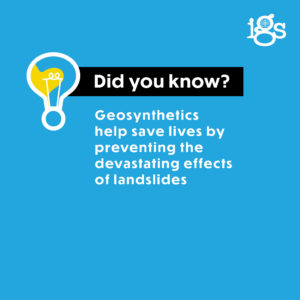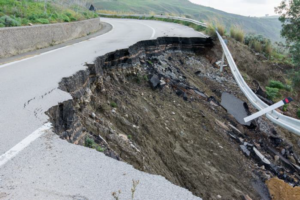
Did You Know?… geosynthetics help save lives by preventing the devastating effects of landslides
The phenomenon of landslides is as old as the hills and can happen anywhere in the world, with potentially deadly and costly consequences.
Landslides are the result of natural processes, typically when rainwater infiltrates soil from above or when groundwater levels rise from below. Landslides may result when weather erodes land, or surface vegetation is lost, for example due to drought. Extreme weather events due to a warming climate mean that landslides are expected to become increasingly frequent and more severe.
Human activities can also increase the likelihood or magnitude of landslides. For example:
-
- Construction can lead to excessive loading on the ground beneath it.
- Inappropriate earthworks such as the creation of artificially steep slopes may reduce the ground’s stability.
- Mine blasting or the removal of deep roots through deforestation can compromise the stability of a slope.
Fortunately, geosynthetics offer a cost-effective, low-impact, and low-maintenance way to prevent landslides and safeguard lives and property.

Even in ancient times, people used fibrous natural materials to improve the mechanical performance of soil. Nowadays, more stable and durable products are available that combine strength with limited deformation, and interact well with the surrounding soil material, while resisting degradation.
Engineers can prevent landslides in a number of ways using geosynthetics:
-
- By performing a barrier function and/or a filter function which prevents the effects of water seepage.
- Using geosynthetics to reinforce the soil, thus making stable even very steep slopes.
- Holding topsoil in place, preventing slippage.
- Allowing excess rainwater to safely drain, without washing the soil away.
- Applying geosynthetics to slope surfaces to encourage the growth of new vegetation, stabilizing slopes through natural means.
- In-filling geosynthetics with soil to provide anchorage to the root structures growing through, thereby increasing their erosion resistance under significant hydraulic stresses.
Clearly, geosynthetics have a significant contribution to make in averting the devastating effects of landslides and land erosion. Their wide use in these applications not only saves time and money but lives and livelihoods.
**
Geosynthetic solutions should be fully investigated on every infrastructure project to ensure they meet the needs of the present without compromising the ability of future generations to meet their own needs.
Find out more about how geosynthetics are making a difference by downloading the IGS Sustainability eBook here or visiting our Sustainability page.






















